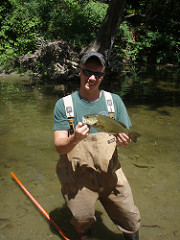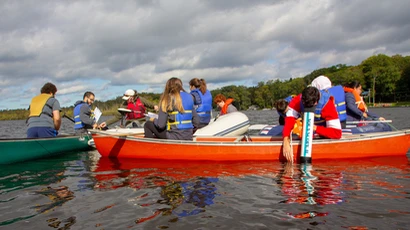
At Fredonia I studied smallmouth bass population genetics. The main concept behind my research was based on the observation that some smallmouth bass live and spawn in Lake Erie where as others live in the lake but spawn in Lake Erie’s tributaries. We wondered if these two different types of smallmouth bass spawners were genetically distinct from each other. To answer this question I started work on a research project when I was an undergraduate and I worked with Cassidy Hahn who was a Master’s student at Fredonia at the time. We collected smallmouth bass tissue samples from a variety of locations in Lake Erie as well as its tributaries. We then used molecular techniques to assess if there were genetic distinctions between the two types of spawners. The work Cassidy and I conducted suggested these different types of spawners we genetically distinct.
I decided to continue my research on smallmouth bass for my Master’s at Fredonia and during that time I was able to collect more smallmouth bass tissue samples from other locations and I was also able to be involved in a radio telemetry study. The radio telemetry study investigated if smallmouth bass returned to the same location to spawn in consecutive years, this is known as site fidelity. Site fidelity is one mechanism that could help to explain the genetic differentiation Cassidy and I observed. To assess if smallmouth bass were displaying site fidelity we surgically implanted transmitters into smallmouth bass spawning in tributaries of Lake Erie as well as others spawning the lake itself. These transmitters were designed to “beep” at very specific radio frequencies and this “beep” could be heard using special equipment. We used this technology to follow the movement of 90 smallmouth bass throughout their spawning season for two consecutive years. Our radio telemetry results corroborated with the genetic work we were conducting. We are currently in the process of submitting our research results to a peer review journal.
I had no idea that committing to the smallmouth bass research project would kindle a passion for population genetics in me but I am certainly happy that it did for a variety of reasons. Conducting research showed me the importance of paying attention to details and perseverance. Research is not always easy and certain aspects of the project may not go according to plan. I experienced the ups and downs of research first hand and it taught me to figure out why things didn’t work and to correct the issues. It also aided in my ability to critically think for myself and consequently I became more comfortable reading peer review literature which is how scientists communicate their research. My research experience has driven me to constantly work towards advancing my understanding of ecology, evolution, and genetics as well. Throughout the four years I conducted research at Fredonia I learned many valuable techniques both in the field and the lab. I was able to harness the power of population genetics to answer important ecological questions about smallmouth bass using these techniques. As with anything it takes practice to be good at what you do. My research project provided me with the opportunity to hone skills I learned in Fredonia’s Biology classes and labs. These techniques have proved very useful for my career. I believe that my research endeavors at Fredonia gave me a competitive edge when applying to Ph.D. programs because research experience is an important factor assessed when applying. My advisor and other professors involved in my project at Fredonia were also great people to ask for letters of recommendation which are often required for post graduate work/studies. Based on my research experience at Fredonia I would highly recommend that anyone interested in a career in biology work on a research project when they are an undergraduate student.
Nick Sard
B.S in Biology, Class of 2009
M.S. in Biology, Class of 2011
Ph.D. student, Fisheries Science, Oregon State University

